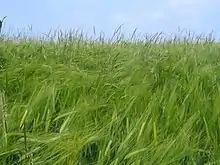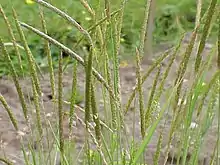Alopecurus myosuroides
Alopecurus myosuroides is an annual grass, found on cultivated and waste land. It is also known as slender meadow foxtail, black-grass, twitch grass, and black twitch.
| Alopecurus myosuroides | |
|---|---|
 | |
| Blackgrass in a barley crop | |
| Scientific classification | |
| Kingdom: | Plantae |
| Clade: | Tracheophytes |
| Clade: | Angiosperms |
| Clade: | Monocots |
| Clade: | Commelinids |
| Order: | Poales |
| Family: | Poaceae |
| Subfamily: | Pooideae |
| Genus: | Alopecurus |
| Species: | A. myosuroides |
| Binomial name | |
| Alopecurus myosuroides | |
Description

It can grow up to 80 cm high, often growing in tufts. The leaves are hairless. Leaf sheath is smooth, green to purplish in colour. The leaf blade is pointed, 3 to 16 cm long, green, rough in texture. The spikelets are cylindrical, yellow-green, pale green or purple in colour.
It flowers from May to August.[1]
Weed status
In the UK, where it is known to farmers as black-grass, it is a major weed of cereal crops as it produces a large amount of seed which is shed before the crop is cut. It has developed resistance to a range of herbicides used to control it. Herbicide resistance testing is often needed to understand what herbicides will be effective at treating it.[2] It can occur at very high densities, competing with the crop and seriously reducing the yield of crops such as wheat and barley if not controlled.
The seeds have a short period of dormancy and viability, and the numbers may be reduced by surface cultivation after harvest.
References
- Grasses by C E Hubbard, 1978, published by Penguin Books
- "Herbicide resistance testing - ADAS". www.adas.uk. Retrieved 2019-06-18.
- UK Weeds Resistance Action Group - advice on Managing and Preventing Herbicide Resistance
- Herbicide Resistance Testing - ADAS
- Jepson Manual Treatment
- Plants of the World Online
- USDA Plants Profile
- Grass Manual Treatment
- USGS Northeast Wetland Flora Profile